Monday, October 14, 2019
Ancient Egypt News 10/14/2019
‘Unexpected’ Discovery Stuns Archaeologist as Long-Lost Tomb FOUND
The find was made in the Aswan region of Egypt (Image: GETTY)
Imhotep was an Egyptian chancellor to the pharaoh Djoser, who is believed to have also been the mastermind behind the Step Pyramid in Saqqara. The Third Dynasty is remembered as being a great author of wisdom texts and also a physician, but the location of his tomb has been unknown for thousands of years, despite great efforts to find it. Until now.
Tony Robinson revealed during his new Channel 5 series “Opening Egypt’s Tomb” how a group of locals stumbled across what archaeologists believe to be Imhotep’s tomb.
Through Gemstones, a Glimpse into ancient Egyptian Civilization
Though these restrung beads were found in a grave in Amara West, in Sudan, they were also likely to have been worn in life, too. The reddish-orange beads are carnelian, the faded-blue beads are faience, and the white are ostrich eggshell, which was very popular in ancient Egypt. (Photo: Spencer et al. Amara West: Living in Egyptian Nubia , 69)
On the second day of fieldwork in Abydos, Egypt, Penn doctoral student Shelby Justl stumbled upon something rare: an inscribed piece of ancient limestone called an ostracon. “You rarely find writing in Egyptian archaeology. Writing is either on papyrus, which decays easily, or on stone that fades over time,” she explains. “I translated the text and determined this was a land-transfer document, a bill of sale of two arouras of land.”
The Chicago Archaeologist Who Changed the Way We Study Civilization
In 1906, James Henry Breasted traveled with his family to Abu Simbel, an archaeological site in Egypt. Image: Courtesy of the Oriental Institute
In 1919, a Chicago man with an opulent handlebar mustache had a radical idea. That man was James Henry Breasted, founder of the Oriental Institute (OI) at the University of Chicago. His radical idea was that scholars should look toward the ancient Middle East, rather than only examining ancient Greece or Rome, to understand the story of western civilization. Now, 100 years later, OI is celebrating its past by looking toward its future.
Breasted was born in 1865 in Rockford, Illinois. He began studying Egyptology at graduate school at the University of Berlin, becoming the first American to hold a PhD in the subject. He started teaching at the University of Chicago in 1894. In addition to his interest in the ancient Middle East, he could read, write, or speak several languages, including Greek, Latin, Aramaic, Syriac, Assyrian, Ancient Egyptian, and more.
From Grappling Art to Pharaonic Propaganda: The History of Wrestling in Ancient Egypt
While wrestling can be found all across the African continent, historical context has greatly focused on ancient Egypt. The country’s incredible Pharaonic tradition and later connection to the Roman Empire made it a topic of interest for Western study. The Victorian era saw the rise of Egyptologists from the English and French gentry, which led to the subsequent proliferation of information on Egypt that also overshadowed the remainder of the continent. As such, much of the information of wrestling’s ancient roots can be traced back to Egypt.
Hawass Announces Two New Archaeological Discoveries (bonus video)
Egypt’s Minister of Antiquities Dr. Khaled Al-Anani announced on Thursday two new archaeological discoveries carried out by an Egyptian expedition in the Valley of the Kings, known as the Valley of the Monkeys in Luxor, under the auspices of prominent archaeologist and Egyptologist Dr. Zahi Hawass.
Dr. Hawass, head of excavation mission, said that the Egyptian expedition, which has been working in the Valley of the Monkeys since December 2017, has succeeded to uncover an industrial area there for the first time ever.
What’s In an Ancient Egyptian Makeup Bag?
Painting from the tomb of Nakht depicting three women (Google images)
From the various looks we have sported across the centuries, the Ancient Egyptian look stands out as one of the more memorable ones in the history of makeup. This is not a surprise, for the Ancient Egyptians were avid lovers of cosmetics. Their heavily kohl-lined eyes are instantly recognizable and often recreated in Hollywood blockbusters, the most famous portrayal being Elizabeth Taylor’s Cleopatra.
Our Dark Materials: Rediscovering an Egyptian Collection
Cartonnage fragments (22231) under visible and ultra violet light.
Our Dark Materials: Rediscovering an Egyptian Collection examines Stanford University's forgotten collection of ancient Egyptian artifacts, which provides insight into the experiences of ordinary Egyptians in daily life and death.
This publication is a digital supplement to a physical exhibit on view in 2018–2019, providing additional content and interactive features. The site uses a non-linear multimedia platform to highlight the special aspects of Stanford University Archaeology Collections’ Egyptian collection: the artifacts’ material qualities, the ways they reflect everyday life and death, and their connections to the history of Egyptology.
Rio Venue to Host Mega Exhibit on Ancient Egypt
Egyptian history is taking over Rio de Janeiro's Centro Cultural Banco do Brasil ( CCBB ) starting October 12. 'Ancient Egypt: from day-to-day to eternity' will feature 140 pieces straight fromMuseo Egizio , in Turin, Italy, which boasts the second-biggest collection on Egypt in the world – trailing only the Cairo Museum, in Egypt's capital.
But curators Pieter Tjabbes and Paolo Marini want more. The idea is to also captivate people unfamiliar with the subject. Tjabbes explains that the exhibit will combine antiquities and 'instagrammable' spots conducive to photos that spread through the internet and ultimately become advertising for an event.
Ancient Egyptian Coffin Contains ‘Oldest Map of the Underworld’ Inscribed 4,000 Years Ago
The ancient doodle was designed to help the dead reach the afterlife by guiding them through the perilous obstacles of the underworld.
The coffin and its artwork were discovered in a burial shaft in the Egyptian necropolis of Dayr al-Barsha.
An inscription on two wooden panels recovered by archaeologists is a mix of hieroglyphs and symbols known to the Ancient Egyptians as The Book of Two Ways.
It depicts two zigzagging lines that detail two routes the dead can use to reach Osiris – the Ancient Egyptian god of the dead – in the afterlife.
EgyptianComposer Mohamed Saad Basha ‘Very Happy’ about Pemiere of His Ballet Cleopatra
Photo: fragment from the Cairo Opera House's ballet Cleopatra promotional material
On four consecutive evenings, from 15 to 18 October, the Cairo Opera Ballet Company and the Cairo Opera Orchestra, conducted by Mohamed Saad Basha, will stage the ballet Cleopatra. The ballet is choreographed by José Perez.
This is the first time that the Cairo Opera House has produced its own take on the famous queen, following a commission of Egyptian composer and conductor Mohamed Saad Basha earlier this year.
“I was commissioned to compose music for a new ballet, Cleopatra, by the Cairo Opera House in February,” composer Saad Basha told Ahram Online.
A Donkey Called Rameses
Scene from the New Kingdom tomb of Panehsy and Tarenu, TT16 (Dra Abu el-Naga)
In the village of Deir el-Medina, the home of the workmen who built the royal tombs of the Valley of the Kings, donkeys were big business. While scenes from the New Kingdom show pharaoh riding a horse-drawn chariot into battle, neither horses nor camels played a part in the day-to-day lives of villagers – camels weren’t even introduced into Egypt until a millennium later (see here). Donkeys were the principal beast of burden, and still play an important part in village life in Egypt today.
"Kenneth Branagh’s ‘Death on the Nile’ to Be Filmed in Egypt."
Wonder Woman’s Gal Gadot, Black Panther’s Letitia Wright, and Call Me by Your Name’s Armie Hammer are all set to star in Kenneth Branagh’s Death on the Nile (photos: Pascal Le Segretain/Getty Images, Rich Fury/Filmmagic, Christopher Polk/Getty Images)
Kenneth Branagh’s Death on the Nile, the sequel to his 2017 box office hit Murder on the Orient Express, has finally been cleared for production, Den of Geek reports. Filming is already underway at Longcross Studios outside London and on location in Egypt. . .
Gang arrested with 193 statues, sarcophagus in Giza
Security forces on Saturday arrested a criminal gang with 193 statues and a sarcophagus in Giza which dates back to the fourth dynasty of ancient Egypt.
The suspects have found the ancient pieces inside a cemetery in Giza. The public prosecution and the Tourism Ministry were notified to take legal action.
In February 2019, a man was arrested over illegally digging under his house in Giza in search for artifacts, as part of Tourism police's crackdown against illicit trade in antiquities.
Picture of the Week
This rare model of the Egyptian scarab beetle creator god Khepri, with a human head and arms emerging from a scarab’s exoskeleton. In many cases, Khepri is presented in a very matter-of-fact way (either as a large beetle or as a human with a scarab for a head) but the above example deserves special mention. It's most likely from the Late Period, ca. 664-332 BC. Now in the Egyptian Museum of Berlin.
Dung beetles were thought to generate spontaneously from the soil and their dung-rolling mirrored the daily journey of the sun disc across the sky. As such, they were potent symbols in Egyptian iconography, representing the solar deity Khepri.
Subscribe to:
Post Comments (Atom)






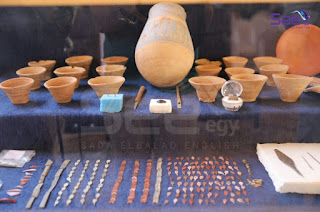

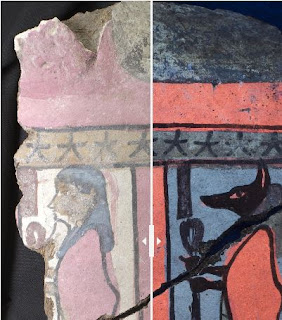
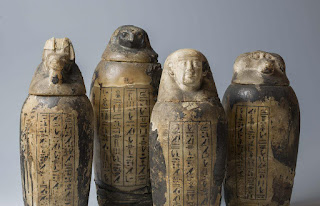


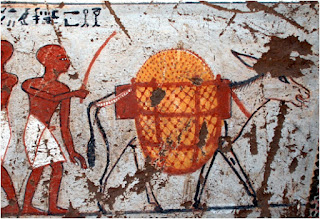

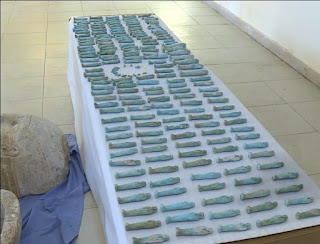

No comments:
Post a Comment
Note: Only a member of this blog may post a comment.